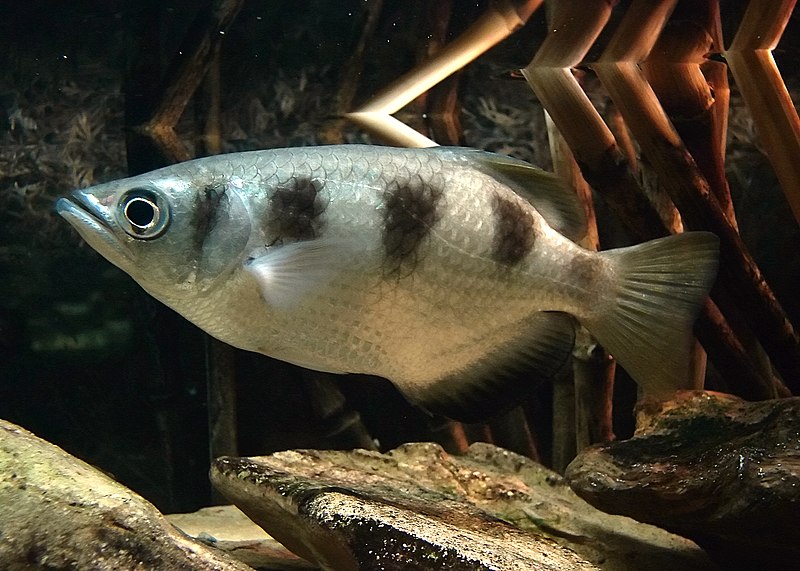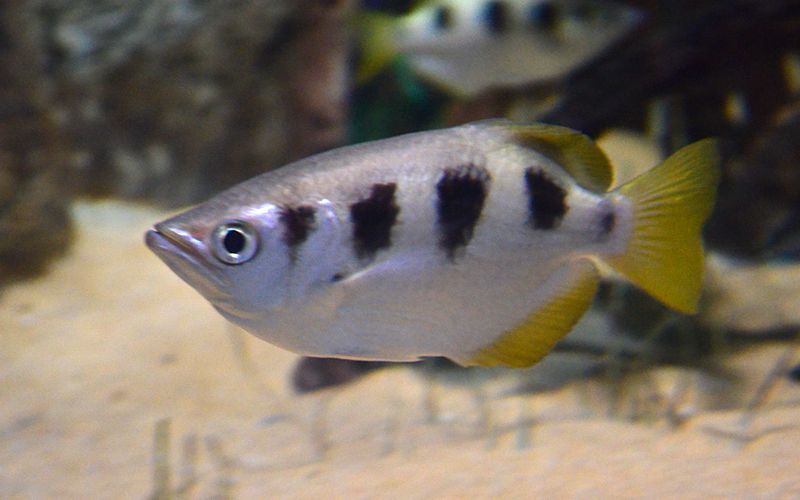 Hello, Frank Indiviglio here. In the early 1980’s, I had the good fortune of being chosen to help set up the exhibits in Jungle World, a new Bronx Zoo building highlighting Southeast Asian wildlife. Leaf Insects, Sunbirds, Marsh Crocodiles, Giant Soft-shell Turtles, Proboscis Monkeys, Tapirs…all came under my care, but it was a mangrove marsh exhibit that became my favorite. It housed a variety of unique animals, including Mudskippers, Fiddler Crabs and Monos, but the real stars were a school of Banded Archerfish (Toxotes jaculatrix). Visitors especially enjoyed watching me service the exhibit…the Archerfishes would invariably squirt water at the movement of my eyes as I looked down at them, and they never missed!
Hello, Frank Indiviglio here. In the early 1980’s, I had the good fortune of being chosen to help set up the exhibits in Jungle World, a new Bronx Zoo building highlighting Southeast Asian wildlife. Leaf Insects, Sunbirds, Marsh Crocodiles, Giant Soft-shell Turtles, Proboscis Monkeys, Tapirs…all came under my care, but it was a mangrove marsh exhibit that became my favorite. It housed a variety of unique animals, including Mudskippers, Fiddler Crabs and Monos, but the real stars were a school of Banded Archerfish (Toxotes jaculatrix). Visitors especially enjoyed watching me service the exhibit…the Archerfishes would invariably squirt water at the movement of my eyes as I looked down at them, and they never missed!
Natural History
Seven archerfish species have been described. They range from India to Malaysia and Australia, ofrten in association with brackish water mangrove swamps, but most also enter freshwater and the ocean. Archers and other species that move between salt and fresh water for other than breeding purposes are known as amphidromous fishes.
At least 1 species, the 5 inch-long Smallscale Archerfish (Toxotes microlepis), spends most of its time in the freshwater. The giant of the genus is the 16 inch-long Largescale or Spotted Archerfish (T. chatareus). Both occasionally appear in the pet trade, where they are often confused with the Banded Archerfish (please see below).
Squirting Water: How and Why?
The environments inhabited by archerfishes are home to an enormous number of insect-eating competitors. In response, archerfishes have evolved a most unique way to exploit a resource unavailable to other fishes.
Archerfishes spend most of their time scanning overhanging branches for insects. When one is sited the fish stops, “takes aim” and forcibly ejects a stream of water at its target. The fish rarely misses, and the dislodged insect falls into the water. The speed with which the archerfish reaches its prize – less than 50 milliseconds according to one study – must be seen to be believed.
The archerfish accomplishes this amazing feat by extending its lower jaw and raising the tongue so that it presses against the roof of the mouth. The bony plates that cover the gills, known as the opercula, are then closed. This process pressurizes water held within the mouth and allows the archerfish to hit insects as far as 6-9 feet away. The Banded Archerfishes under my care were accurate at 2-4 feet; unfortunately, I did not have a chance to test their maximum range.
Just as fascinating as the actual water-shooting process is the fact that, when taking aim at its moving target, the archerfish must somehow allow for the distortion of light as it enters the water!
Archerfishes are also very athletic jumpers, and often leap out of the water to snatch insects from branches…I assume there is a “leap or shoot” decision process, but I’ve not read of any related studies.
Learning to Hunt: Interesting Observations
 This technique is obviously quite complex, and recent studies have shown that young archerfishes may learn from others, and that their accuracy improves over time if they are able to observe successful hunters. Researchers have even been able to train captives to be better “archers”! Young fish school together, and there is evidence that many will shoot at a single insect in an attempt to improve their chances of obtaining a meal.
This technique is obviously quite complex, and recent studies have shown that young archerfishes may learn from others, and that their accuracy improves over time if they are able to observe successful hunters. Researchers have even been able to train captives to be better “archers”! Young fish school together, and there is evidence that many will shoot at a single insect in an attempt to improve their chances of obtaining a meal.
The Banded Archerfish, Toxotes jaculatrix
Description
The Banded Archerfish is most commonly seen in the pet trade. It may reach 12 inches in length, but I’ve not seen individuals exceeding 7.5 inches.
The deep, oblong body is silvery-white on the sides and bottom, and sometimes tinged with yellow. The upper body is olive-green to brown in color, and four to six broad, dark, wedge-shaped bands extend down the sides. The large eyes are close set, allowing for an unusual (for fishes) degree of binocular vision, and the mouth is long and pointed.
Range and Habitat
The Banded Archerfish occupies a huge range that extends from India to Indonesia, the Solomon Islands, Papua New Guinea and northern Australia. It is most commonly found in mangrove swamps (please see photo).
Despite its wide distribution, the Banded Archerfish may face an uncertain future, as the mangrove swamps upon which it depends are among the earth’s most threatened habitats.
The Aquarium
It seems a shame to house these fascinating fishes in a situation that does not allow for the use of their unique abilities. They are, therefore, best kept in a “tall style” or very large aquarium that is a half filled with water, over which has been positioned branches and plants.
Archers are accomplished jumpers, so the aquarium should be well-covered. Being quite active, they should be given as much room as possible.
Several individuals under my care reached 8-10 years of age; some may now be much older, but I’ve not had a chance to check with their current keepers.
Salinity
Banded Archerfishes will do well in typical brackish water aquariums at a specific gravity of 1.005. Fluctuations in salinity (i.e. between 1.002 and 1.007) are well-tolerated and may even be beneficial.
Temperature
Archerfishes thrive at temperatures of 76 – 85 F; I have found 82 F to be ideal.
Companions
Although they get along well with each other and other similarly-sized brackish water fishes, Archers are aggressive feeders. Therefore, pay particular attention to each individual at feeding time.
I’ve successfully kept Banded Archerfishes with Mudskippers, Scats, Monos, Bumblebee Gobies, Hermit and Fiddler Crabs and various snails.
Feeding
 Although they are insect specialists, Banded Archerfishes have expansive appetites and will readily consume all manner of flake, pelleted and frozen fish foods. They do, however, relish live insects above all else, and will put on quite a show if crickets are released onto the branches overhanging their aquarium. Archers will also benefit from occasional meals of wild-caught grasshoppers, moths, spiders, beetles and earthworms.
Although they are insect specialists, Banded Archerfishes have expansive appetites and will readily consume all manner of flake, pelleted and frozen fish foods. They do, however, relish live insects above all else, and will put on quite a show if crickets are released onto the branches overhanging their aquarium. Archers will also benefit from occasional meals of wild-caught grasshoppers, moths, spiders, beetles and earthworms.
If live insects are not available, base the diet on frozen prawn, clams and other “meaty” foods. Canned insects marketed for captive reptiles are also worth investigating. Individuals maintained on flakes and pellets alone do not do as well as those provided a diet comprised of insects and frozen marine invertebrates.
Distinguishing the Species
The Largescale and Smallscale Archerfishes, which occasionally appear in the trade, are superficially similar to the Banded Archerfish.
The Largescale Archer has five dorsal spines as opposed to the Banded Archer’s four spines. It is darker in color, spotted, and its bands are shorter than those of the Banded Archerfish.
The bands of the Smallscale Archer do not extend to the dorsal fin, as do those of the Banded Archerfish.
Further Reading
Video: Archerfish Hunting Insects
Archerfish Natural History and Photos (all species)
Algae and Plants for Brackish Water Aquariums
Breeding Freshwater Archerfishes
Banded Archerfish image referenced from wikipedia and originally posted by ChRumps
Mangrove Swamp image referenced from wikipedia and originally posted by Fanny Schertzer
Largescale Archerfish image referenced from wikipedia and originally posted by Esquilo
 That Fish Blog – Aquarium Advice and Information
That Fish Blog – Aquarium Advice and Information


Nice Post Frank, very thorough and full of interesting details. Cheers, Franck.
Much appreciated, Franck.
best regards, Frank
Hallo Frank
Thank you for this much inspiring article!
My following question how ever, I think I already have the answer….but I’ll ask anyway!
I have a 1mtr x 1mtr x 0.5mtr high (water level) aquarium…obvious kind of very small.
The original idea was to host a group of 4-6 archer fish together with one specie of puffer.
I am familiar with the feeding habits and know the hard work actually lies in the constant supply of their desirable food….BUT the actual question is wither this small aquarium would be appropriate?!
Best fishes from Namibia
Gert
Hi Gert,
Nice to hear from you. They would quickly outgrow a tank of that size, or become stunted, especially considering that water level needs to be dropped a bit if you want to see their hunting behavior. A pair might get by, and it would be ideal for several types of brackish puffers….they too are quite interesting. Their eyes are rather movable as fish eyes go, and they seem to “focus” on you. Several of the US natives I’ve kept are crustacean specialists; they ‘dismantle” small crabs leg-by-leg before moving in for dinner. Pl let me know how all goes, and if you need any info, best, frank
I have 2 archer fish which ive had for nearly a year when i got them they were identical but now there close to 4 to 5 in long there appearance and personality are completely different there body shape is different one is bigger and rounder and a bit lighter and the other is smaller more pointy and markings are darker and if they feel threatened the larger one goes virtually completely white and hides and the other protects it and isnt scared and changes to nearly black all over do you think i have a male and female ? As no one can tell me because if they are i want to try and breed even though ive been told it quiet difficult ! Any info would help thanks mate
Hello Nick,
Differences in the sexes have not been identified…there is a good deal of variation among individuals, however, so it’s difficult to tell if what you are seeing is related to their sex.
I have not been able to find any records of captive breeding in zoos or aquariums. Brackish water fish are often keyed to breed by tidal influences, changes in salinity and season, etc….these are difficult to duplicate in captivity. Keep watching them and take notes, as we have much to learn about them. Enjoy, Frank